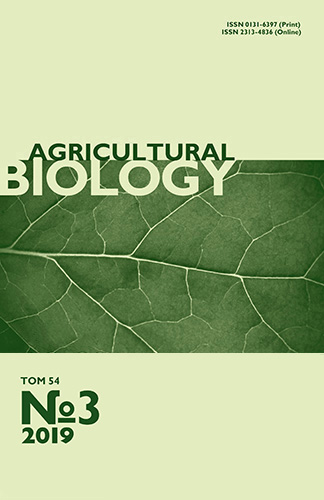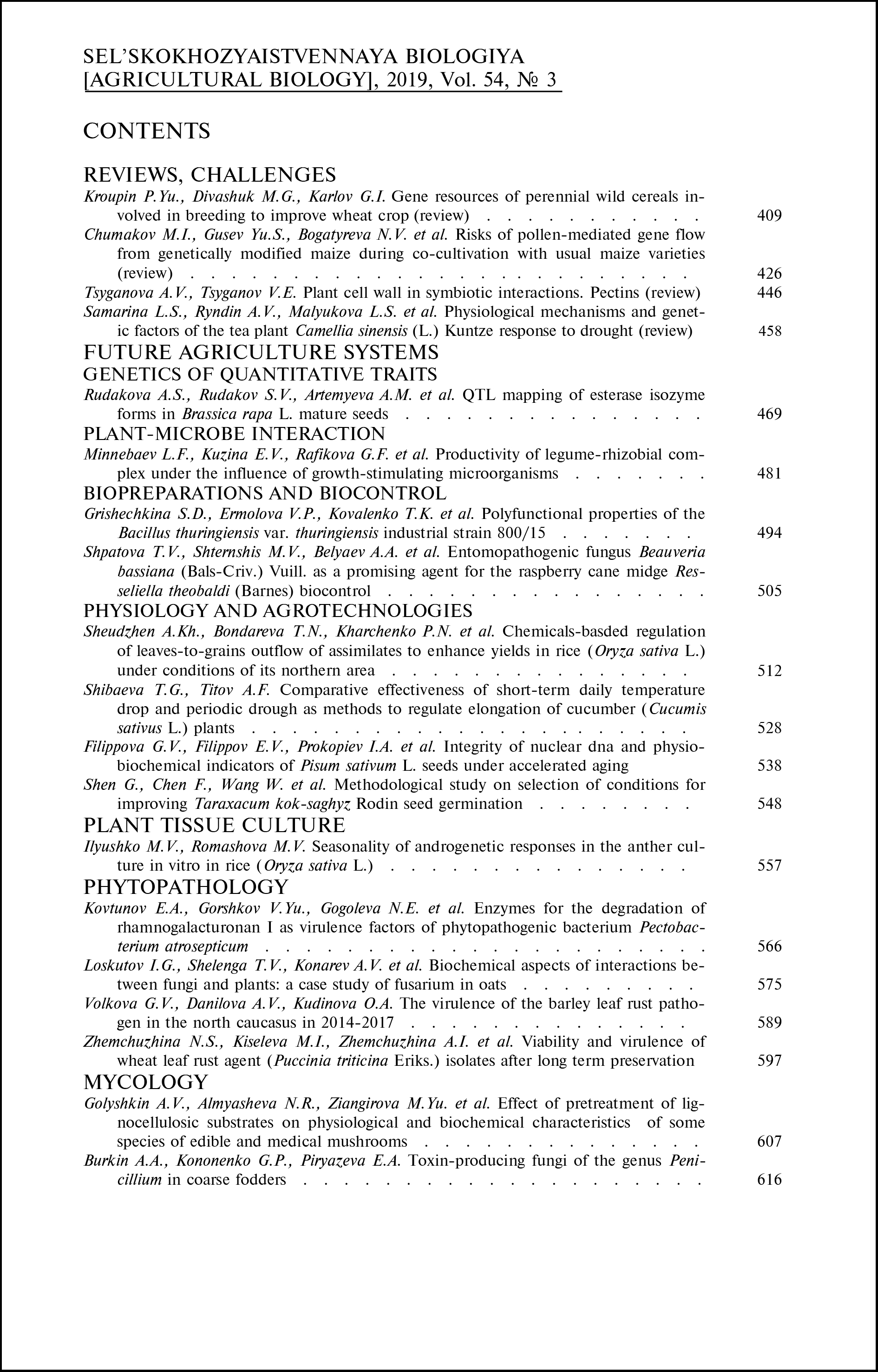doi: 10.15389/agrobiology.2019.3.597eng
UDC: 633.11:632.4.01/.08:577:57.082.5
VIABILITY AND VIRULENCE OF WHEAT LEAF RUST AGENT (Puccinia triticina Eriks.) ISOLATES AFTER LONG TERM PRESERVATION
N.S. Zhemchuzhina, M.I. Kiseleva, A.I. Zhemchuzhina, S.A. Elizarova
All-Russian Research Institute of Phytopathology, 5, ul. Institute, pos. Bol’shie Vyazemy, Odintsovskii Region, Moscow Province, 143050 Russia, e-mail zhemch@mail.ru (✉ corresponding author), kiseleva@vniif.ru, zhemchuzhina@vniif.ru, elizarova@vniif.ru
ORCID:
Zhemchuzhina N.S. orcid.org/0000-0001-6374-403X
Zhemchuzhina A.I. orcid.org/0000-0002-2060-3306
Kiseleva M.I. orcid.org/0000-0001-7813-3266
Elizarova S.A. rcid.org/0000-0001-9224-8430
Received July 5, 2018
The State Collection of phytopathogenic microorganisms (ARRIP) accumulates a great number of wheat leaf rust agent (Puccinia triticina Eriks.) isolates, an extremely harmful and epiphytotic pathogen. Annually the collection is replenished with new leaf rust isolates from different populations. Annual estimation of the virulence genes’ frequency in isolates makes it possible to track the dynamics of the fungal populations. One of the main tasks of the State collection is to preserve the isolates of the fungus without losing their biological properties to involve these isolates in further laboratory and field experiments. For this purpose, the viability and virulence of P. triticina collection isolates was evaluated during 10-year preservation in a household refrigerator (+4 °С) and in a REVCO freezer (-80 °С, Revco, USA). We used 124 P. triticina isolates collected in 2005, 2006, 2008, 2009, 2010 and 2012 from damaged wheat (Triticum aestivum L.) samples in the Central, North Caucasus and West Siberian regions of the Russian Federation. The isolates differed in virulence and were assigned to 74 phenotypes. The viability of the isolates after storage was determined by spore germination on 2 % water agar plates and by inoculation of susceptible wheat cultivars. Storing of the leaf rust uredospores at low positive temperatures quickly led to a weakening of the viability of the fungus, up to complete destruction. After 1-2 months at +4 °С, the isolates had a high germination capacity, from 48 to 95 %, which decreased in 6 months to 3.0-22.7 %. The correlation between the number of germinated spores on 2 % agar-agar and the duration of storage at a low positive temperature was 0.79. Leaf rust isolates remained viable during storage for 3-10 years under low negative temperatures (-80 °С). The number of germinated spores of different isolates regardless of the preservation period was 25-79 %, and the disease intensity reached 25-100 %. Many factors influence viability of isolates. These mostly are improper sample processing prior to putting into storage and during reviving from an anabiotic state, or disturbance of storage of technical character. However, storage of P. triticina isolates at low negative temperatures ensured a rather high survival rate for 10 years. Checking the virulence of the isolates after 7-year storage with the use of susceptible wheat cultivar and Lr9 and Lr19 lines showed identical indicators before and after the storage. The method of storing spores at -80 °C allows rather high rate of preservation without changing fungal viability and virulence.
Keywords: collection of microorganisms, leaf rust, isolate, population, virulence, preservation.
REFERENCES
- Katalog shtammov Gosudarstvennoi kollektsii fitopatogennykh mikroorganizmov i sortov rastenii — identifikatorov (differentsiatorov) patogennykh shtammov mikroorganizmov [Catalog of strains of the State collection of phytopathogenic microorganisms and differentiating varieties]. Bol'shie Vyazemy, 2009. Available http://www.vniif.ru/vniif/structure/collection/. No date (in Russ.).
- Zhemchuzhina N.S., Kiseleva M.I., Abramova S.L., Makarov A.A. Zashchita i karantin rastenii, 2014, 1: 48-50 (in Russ.).
- Kiseleva M.I., Zhemchuzhina N.S., Kovalenko E.D., Dubovoi V.P., Makarov A.A. Zashchita i karantin rastenii, 2014, 1: 50-52 (in Russ.).
- Kolmer J.A. Genetics of resistance to wheat leaf rust. Annual Review of Phytopathology, 1996, 34(1): 435-455 CrossRef
- Singh R.P., Huerta-Espino J., William H.M. Genetics and breeding for durable resistance to leaf and stripe rusts in wheat. Turk. J. Agric. For., 2005, 29: 121-127.
- Kovalenko E.D., Zhemchuzhina A.I., Kiseleva M.I., Kolomiets T.M., Shcherbik A.A. Zashchita i karantin rastenii, 2012, 9: 19-22 (in Russ.).
- Oelke L.M., Kolmer J.A. Characterization of leaf rust resistance in hard red spring wheat cultivars. Plant Disease, 2004, 88(10): 1127-1133 CrossRef
- DadrezaieS., Lababidi S., Nazari K., Goltapeh E., Afshari F., Alo F., Shams-Bakhsh M., Safaie N. Molecular genetic diversity in Iranian populations of Puccinia triticina, the causal agent of wheat leaf rust. American Journal of Plant Sciences, 2013, 4(7): 1375-1386 CrossRef
- Kosman E., Ben‐Yehuda P., Manisterski, J. Diversity of virulence phenotypes among annual populations of wheat leaf rust in Israel from 1993 to 2008. Plant Pathol., 2014, 63: 563-571 CrossRef
- Kovalenko E.D., Kolomiets T.M., Kiseleva M.I., Zhemchuzhina A.I., Smirnova L.A., Shcherbik A.A. Metody otsenki i otbora iskhodnogo materiala pri sozdanii sortov pshenitsy ustoichivykh k buroi rzhavchine [Methods for assessing and selecting the source material when creating wheat rust resistant varieties]. Moscow, 2012: 1-93 (in Russ.).
- Kolmer J.A., Liu J.Q. Simple inheritance of partial leaf rust resistance in two wheat cultivars. Plant Pathology, 2001, 50(5): 546-551 CrossRef
- Kovalenko E.D., Zhemchuzhina A.I., Kiseleva M.I., Kolomiets T.M., Shcherbik A.A. Zashchita i karantin rastenii, 2012, 9: 19-22 (in Russ.).
- Liu T.-G., Ge R.-J., Ma Y.-T., Liu B., Gao L., Chen W.-Q. Population genetic structure of Chinese Puccinia triticina races based on multi-locus sequences. Journal of Integrative Agriculture, 2018, 17(8): 1779- 1789 CrossRef
- Bolton M.D., Kolmer J.A., Garvin D.F. Wheat leaf rust caused by Puccinia triticina. Molecular Plant Pathology, 2008, 9: 563-575 CrossRef
- Morgan C.A., Herman N., White P.A., Vesey G. Preservation of micro-organisms by drying; a review. Journal of Microbiological Methods, 2006, 66(2): 183-193 CrossRef
- Strei W.R., Schmitz R.A. Metagenomics — the key to the uncultured microbes. Current Opinion in Microbiology, 2004, 7(5): 492-498 CrossRef
- Miyamoto-Shinohara Y., Sukenobe J., Imaizumi T., Nakahara T. Survival of freeze-dried bacteria. The Journal of General and Applied Microbiology,2008, 54(1): 9-24 CrossRef
- Pokhilenko V.D., Baranov A.M., Detushev K.V. Izvestiya vysshikh uchebnykh zavedenii. Povolzhskii region. Meditsinskie nauki, 2009, 4(12): 99-121 (in Russ.).
- Smith D., Onions H.S. The preservation and maintenance of living fungi. CAB International, Wallingford, UK, 1994.
- Volkov V.Ya. Mikrobiologiya, 1994, 63(1): 5-16 (in Russ.).
- Kitamoto Y., Suzuki A., Shimada S., Yamanaka K. A new method for the preservation of fungus stock cultures by deep-freezing. Mycoscience, 2002, 43(2): 143-149 CrossRef
- Muldrew K., McGann L.E. Cryobiology — a short course. University of Calgary, Alberta, Canada, 1999.
- Wolfw J., Bryant G. Cryobiology and anhydrobiology of cells. RMIT University, Melbourn, Australia, 2004.
- Tedeschi R., De Paoli P. Collection and preservation of frozen microorganisms. In: Methods in Biobanking, Methods in Molecular Biology, Vol. 675. J. Dillner (ed.). Humana Press, Totowa, NJ, 2011: 313-326 CrossRef
- McIntosh R.A., Dubcovsky J., Rogers W.J., Morris C., Appels R., Xia X.C. Catalogue of gene symbols for wheat, 2013. Available https://wheat.pw.usda.gov/GG2/Triticum/wgc/2013/. No date.
- Hanzalová A., Bartoš P. Physiologic specialization of wheat leaf rust (Puccinia triticina Eriks.) in the Czech Republic in 2001-2004. Czech J. Genet. Plant Breed., 2006, 42(4): 126-131.
- Peterson R.F., Campbell A.B., Hannah A.E. A diagrammatic scale for estimating rust intensity of leaves and stem of cereals. Canadian Journal of Research, 1948, 26c(5): 496-500 CrossRef
- Kolmer J.A. Physiologic specialization of Puccinia triticina in Canada in 1998. Plant Disease, 2001, 85: 135-138.
- Uzunova-Doneva T., Donev T. Anabiosis and conservation of microorganisms. Journal of Culture Collections, 2005, 4(1): 17-28.
- Maintenance of microorganisms. A manual of laboratory methods. B.E. Kirsop, J.J.S. Snell (eds.). Academic Press, London, UK, 1984.
- McCann C.M., Wade M.J., Gray N.D., Roberts J.A., Hubert C.R.J., Graham D.W. Microbial communities in a high Arctic polar desert landscape. Front. Microbiol., 2016, 7: 419 CrossRef












